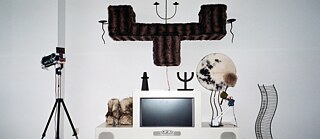Henrike Naumann & Bastian Hagedorn
Exhibition “Techno Worlds”
The Museum of Trance (2021)
In music history, trance is usually described as a particularly German phenomenon within techno culture. However, the genre could only emerge as a singular musical style within specific intercultural and international conditions.
Whereas techno referred more to the industrialised, mechanised society as a futuristic element, along with the captivating power of the sound derived from it, trance focussed on the hypnotic potential of primeval musical rituals and their continuation in the musical practices of today's indigenous cultures. This fact must be critically emphasised in the reception of the genre within the context of the cultural appropriation of musical styles. At the same time, certain questions arise: To what extent are rituals of spirituality being lost in a highly mechanised society? In what form can music act as a substitute? Can the use of new technologies even enable such a reconquest?
In 2015, the artists Bastian Hagedorn and Henrike Naumann opened the Museum of Trance in Port-au-Prince, Haiti, in which they exoticised German rave culture and musealised it as “other” in Haiti. The new multimedia work Museum of Trance (2021) continues these reflections on spirituality, rave culture, exoticism and otherness. This video piece ostensibly follows a young team of researchers in their rediscovery of trance culture in and around Berlin. To reconstruct the phenomenon, the researchers use archaeological methods and practices of reenactment. Using modern technical equipment, they attempt to use found objects as instruments. Captivated by their findings, they put the pieces of the puzzle together, extrapolating a primeval ritual to revive the spirits of the past. In the video, the layers become blurred, and the references overlap. Are the researchers looking for Germanic relics and ancient evidence of the origins of trance, or is this a reconstruction of the trance of the 1990s?
Biography
Henrike Naumann, born in Zwickau, lives and works in Berlin. She reflects socio-political problems on the level of interior design and domestic space and explores antagonistic political beliefs through the ambivalent aesthetics of personal taste. In her immersive installations she arranges furniture and home decor into scenographic spaces interspersed with video and sound work. Growing up in Eastern Germany, Naumann experienced extreme-right ideology as a predominant youth culture in the 1990s. Therefore, she is interested in the mechanisms of radicalization and how they are linked to personal experience. Although rooted in her experiences in Germany, Naumann’s work has addressed the global connectivity of youth cultures and their role in the process of cultural othering.
Bastian Hagedorn is an experimental percussionist, drummer and composer. He graduated from the Alice Salomon University of Applied Sciences in Berlin with a Bachelor of Arts in Social Work and is currently a touring musician as well as a multimedia artist. His work explores the potentials of unconventional musical styles – such as noise, gabber, black metal and free improvisation – as a form of artistic language, as well as the transcendent dimensions of the rhythmic. In his mostly collaborative installations and performances, he negotiates utopian and dystopian scenarios of current technological developments with regard to their effects on socio-cultural phenomena and everyday rituals. In his output, specific sound design and the use of mechanical automation amplify the results of his reflections.
